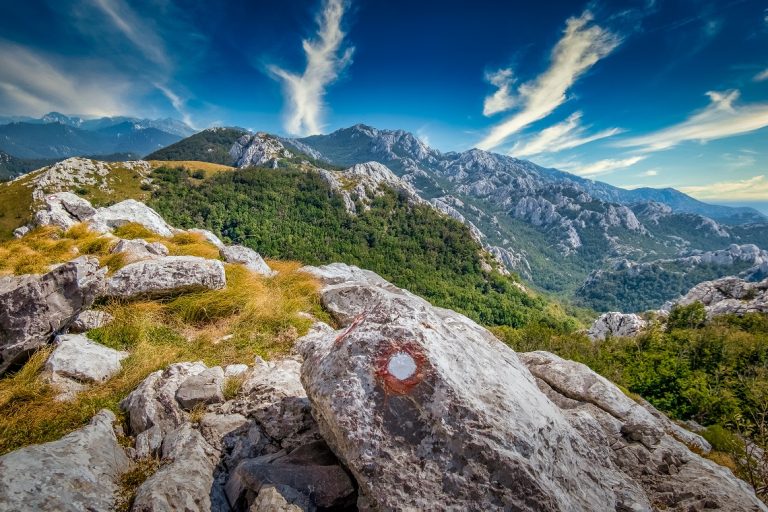SECRET CROATIA
There’s more to CROATIA than sun, sea, and Game of Thrones sets. The Balkan state is HIDING one of Europe’s great TREKS in the VELEBIT Mountains
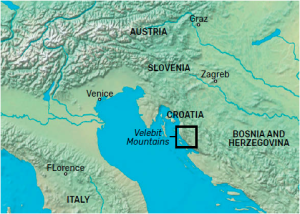 When people think of trekking in Europe, they invariably conjure the Alps — and why not? Europe’s most celebrated chain of mountains spreads some 750 miles across the continent piercing no fewer than 11 countries in the process. The range is home to classic European treks such as the Chamonix-Zermatt Haute Route or the Tre Cime di Lavaredo in the Dolomites.
When people think of trekking in Europe, they invariably conjure the Alps — and why not? Europe’s most celebrated chain of mountains spreads some 750 miles across the continent piercing no fewer than 11 countries in the process. The range is home to classic European treks such as the Chamonix-Zermatt Haute Route or the Tre Cime di Lavaredo in the Dolomites.
But hidden in the southeastern corner of the massif, separating continental Europe from the Adriatic coast, lie the Velebit Mountains, Croatia’s largest range and one of Europe’s most overlooked highland landscapes. Last autumn, I joined a trek across the ridgelines of the Velebit and discovered a quiet alpine region of Europe perfect for shaking off those post-lockdown cobwebs.
ENTER THE VELEBIT
If I’m honest, I hadn’t considered visiting Croatia since a long weekend in Zagreb nearly 15 years ago. Of course, I’d heard stories about its glorious coastline and walled cities, but I typically plan my travels around footpaths and I’d heard nothing of the Velebit Mountains or trekking in Croatia in general. The rugged limestone peaks of the Velebit form part of the Dinaric Alps, a range running parallel to the Dalmatian coast for 90 miles wedged between the continental Balkan Peninsula and the Adriatic Sea.
The belt of mountains may be home to the country’s most dramatic alpine vistas, but few tourists to Croatia tend to stray far from the Adriatic coast. Trekking isn’t high on many people’s agendas when visiting Balkan country. The azure waters, pebble beaches, and ancient walled towns are the usual pull.
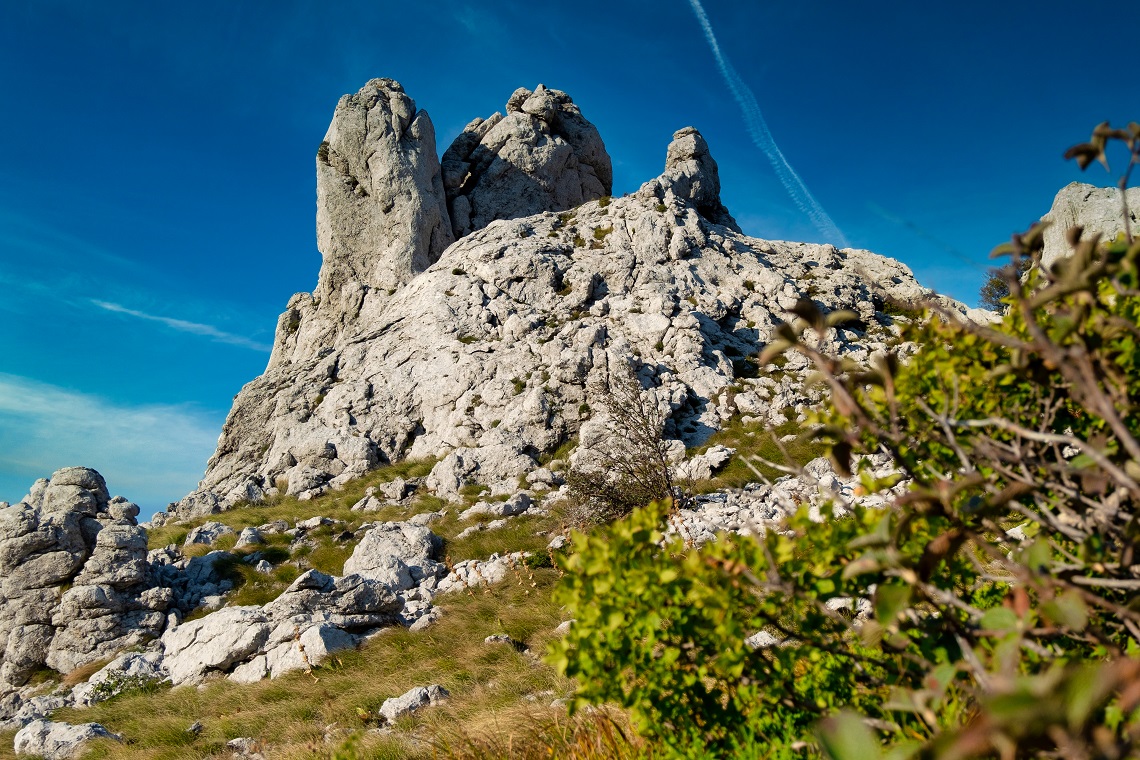
Visitors may stay a while in Zagreb, to stroll the cobblestone streets or take a detour to see the crystalline lakes of Plitvice before making the conventional beeline for the coast, but very few will venture up the slopes of the Velebit. The upland region receives just a fraction of the footfall compared to the classic coastal haunts of Dubrovnik, Split, and Hvar.
I was scheduled to join a five-day trek beginning in the Northern Velebit National Park. The 65-mile trail works its way southeastwards along the chain of mountains crossing into the Paklenica National Park before turning towards the coast to finish at the resort town of Starigrad near Zadar. September is the ideal time to hike in Croatia. It’s cooler during the heat of the day, but still warm enough to enjoy a dip in the sea at the end of the trek. It’s also a fine time of year to visit Croatia in general as it’s naturally quieter and cheaper than the high-summer season.
SEMI-SUPPORTED TREKKING
I’ve been on dozens of multi-day treks all around the world — my work as an outdoor travel writer and photographer largely depends on it. These treks typically fall into one of two styles. Either they are fully supported with a team of guides, porters, and cooks who help clients by carrying gear, pitching camps, and preparing meals or they’re entirely self-sufficient expedition-style treks where I’m responsible for everything from logistics and route planning to carrying all my food, supplies, and equipment for days — sometimes weeks — at a time.
The Velebit trek was with Croatia-based hiking company Highlander Adventure, which organises semi-supported trekking events. The logistics, including internal travel to and from the trailheads, route, food, and checkpoints are all arranged. Participants are only responsible for organising their personal gear including a tent or shelter and getting themselves to the rendezvous point before the trek.
The events are non-competitive but there are daily checkpoints to pass through where hikers get a logbook stamped and collect dehydrated meals for the day. There are designated camping areas at each checkpoint, but hikers are free to camp anywhere they wish or take an alternative route as long as they pass through all the checkpoints. All the information about the trail is provided including maps and GPS files. I have to say, it’s a thoroughly enjoyable way of trekking and strikes a nice balance between a guided trek and a self-sufficient expedition.
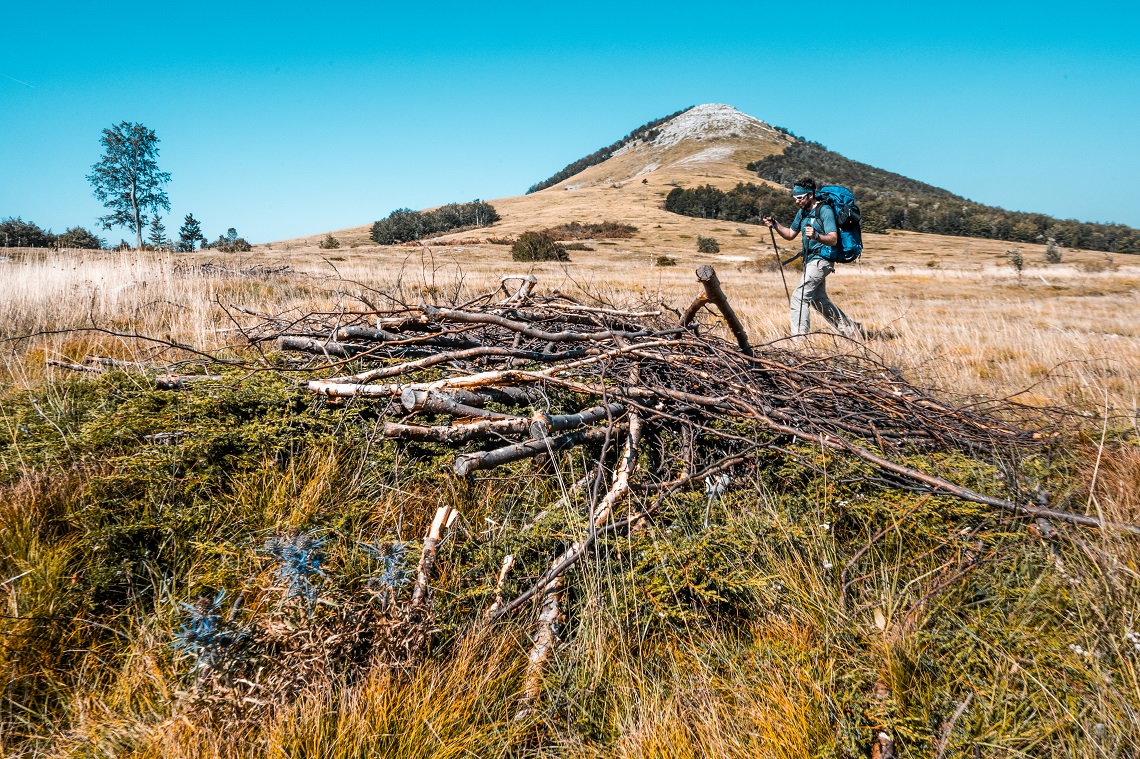
ON THE TRAIL
On the first day of the trail, around 200 hikers converged at the trailhead at the Zavižan mountain hut and weather station at the entrance to the Northern Velebit National Park. While that sounds like a lot of hikers, start times were carefully staggered. Participants collected their maps and first meal pack before the starting bell was rung by renowned Croatian mountaineer Stipe Božic, who has twice summited Everest as well as several other notable high-altitude climbs.
Initially, I was a bit concerned by the throng of hikers gathered at the start line. I prefer my hiking quiet and trails unbusy. But within a few minutes of walking, trekkers had dispersed, moving at their own pace and in their own troops. Soon enough, I found myself alone on the trail without a soul to be seen in either direction. I slipped into the familiar beat of hiking and my mind began to disentangle.
There is a sense of balance and perspective that comes only from being in nature. When on the trail, my mind clears of all the distractions of the modern world and settles into a wonderfully uncomplicated routine: walk, rest, repeat. Hiking, for me, is the remedy to most of life’s problems insofar as they simply cannot be addressed from the trail. The unanswered emails, pending mortgage repayments, and ceaseless news headlines, all just have to wait when I’m on an adventure like this. The rhythmical crunch of rocks underfoot, the smell of sea salt on the breeze, and the contours of the footpath ahead were all I had headspace for now.
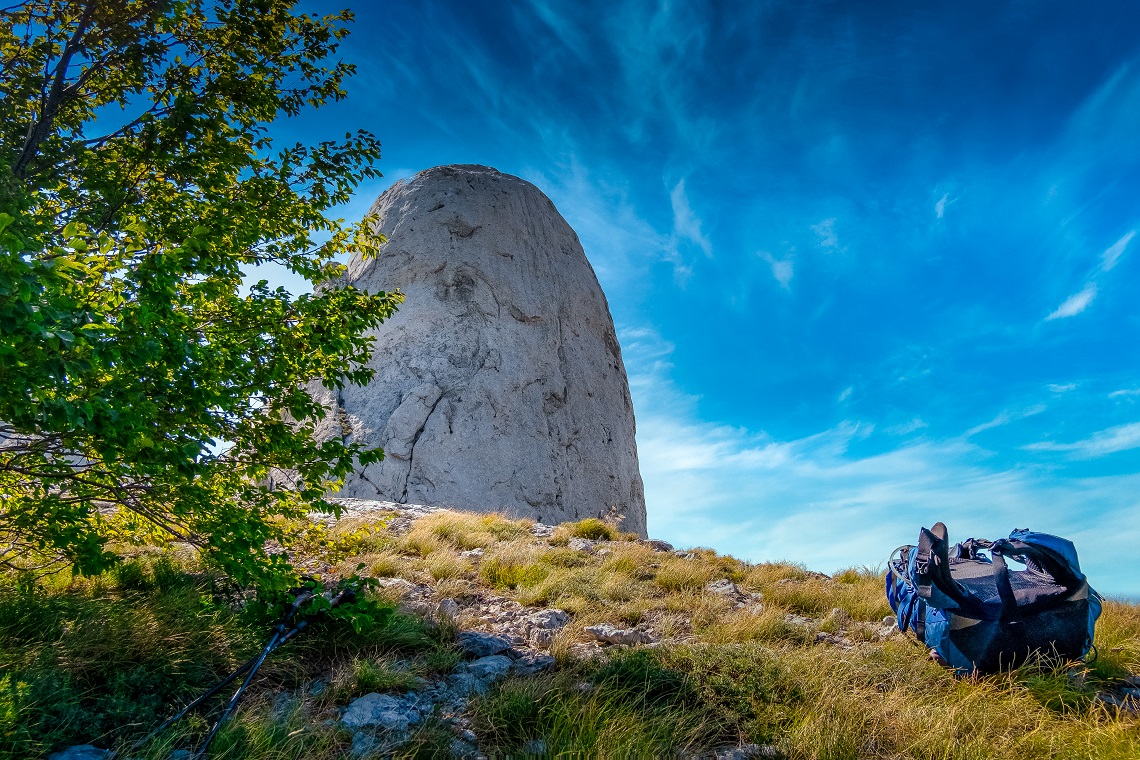
The first day was essentially a microcosm of the entire trek with the scenery forever shifting. The trail effortlessly slipped from one landscape to another: in and out of thick pine forest, snaking through rocky ravines and then breaking out into expansive grasslands or overexposed ridges with sweeping Adriatic views. After months of restrictions and precautions, I was relieved to finally put some miles in my legs. It was refreshing to be back in the mountains and not have to think about wearing a mask or social distancing. This was exactly what I needed.
The first day was also the longest in terms of distance, although not actually the hardest as it was more downhill than up. In total, it was just under 21 miles from the start of the trek to the first checkpoint at a refuge called Skorpovac. The small wooden mountain hut is located in the forest with a simple shelter, a well for drinking water, and a large clearing with ample space for campers to pitch. Most importantly of all, there was a can of Croatian beer waiting for every hiker who arrived at the checkpoint that evening — a thoroughly well-deserved reward after a long, sweaty day on the trail.
That evening, after pitching my tent, I got to know some of my fellow hikers and had my first taste of Croatian highland hospitality. A group of hikers had brought with them some treats for the first night, so I cosied up to them and spent the evening eating hearty sausages and fresh bread over several glasses of rakia, a type of brandy popular in the Balkans. Sated and cheered, I slept well in my tent that night.
MOVIE NIGHT
Compared to the first day, the second was a short and sweet 9-mile jaunt. Following a brief wooded section, the trail broke out into a wide expanse of meadowland and then picked its way over a rocky series of elevated peaks strung along a craggy ridge parallel to the coast. The view was outstanding: to the right lay the gleaming Adriatic stippled with rocky islands, while to the left stood rolling hills of beech forest.
I took a short break at the crown of a ridge and let the sun wash over me, warming my bones. I’m fortunate to live on the edge of the Yorkshire Dales National Park and so routinely make forays into the Dales to get my regular fill of nature. But sitting on that escarpment, bathed in the hot Mediterranean sun, the chilly valleys of Yorkshire felt like a world apart. This wasn’t just a trek; it was a holiday.
The checkpoint that night, at Baške Oštarije, was the most civilised of the trek, with a small campground located alongside a hostel with a beer garden. The evening was spent chatting to hikers over cold beers and watching a lecture by Stipe Božic on his Everest and K2 summits. Božic is Croatia’s most successful Himalayan climber. He has completed the seven summits and is the second European, after Reinhold Messner, to have climbed Everest twice.
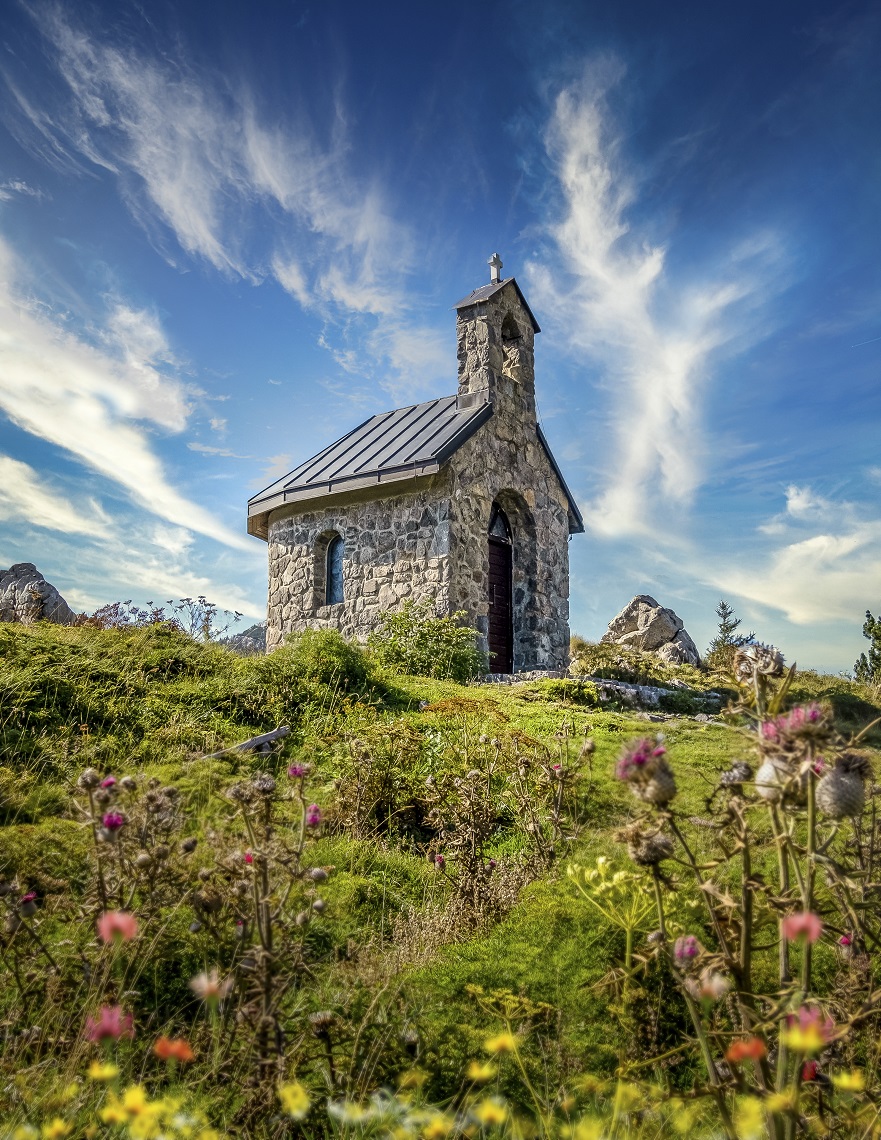
As an aspiring seven-summiteer myself (four down, three to go) it was an inspirational evening. I could tell I wasn’t the only one captivated by his stories. Božic had pulled in quite the crowd who, despite watching from a beer garden, sat in silence, hooked on his every word. Božic’s presentation was mostly in Croatian but included plenty of photography from his expeditions and still proved thoroughly entertaining.
On the third day, we really got down to business, covering around 12 miles and ascending over 1,000m. The weather had been nothing but hot and dry throughout and this was amplified during a tough morning ascent through a stiflingly still, thick forest. Fallen trees and dense vegetation made for a painfully slow section of the trail. The airless heat, several steep ascents, and swarms of mosquitoes made the mid-morning escape from the forest into open grassland a welcome relief.
The rest of the day was far more agreeable. Despite several steep climbs, the trail largely traversed exposed terrain accompanied by a cool breeze. I arrived at the day’s checkpoint mid-afternoon and was pleased to find another can of beer waiting for me. The stamp for that checkpoint was located at the summit of Mt Panos, a short walk away at the top of a rocky outcrop that was once a military post. I sat just below the peak and enjoyed the sunset.
There, watching the sun linger on the horizon, I paused and enjoyed one of those rare moments that make you feel like you’ve done everything right in life. As the sun dipped below the Adriatic, the crisp chill of night crept up the mountain reminding me it was time to return to the campsite to pitch my tent for the night.
COMING DOWN
I spent the morning of the fourth day hiking through some upland meadows dotted with unusual rock formations. The most distinctive of which was the 100m-high Stapina monolith, its peculiar shape rising quite unannounced from the surrounding plain. Its long shadow made for the perfect lunch spot.
The trail then descended into wide-open pastures that began to show signs of returning to civilisation as the scenery opened up into a wide plateau dotted with trees, farmhouses, and stone walls. The trail led to the hamlet of Veliko Riujno, a collection of farmhouses and a small chapel, the churchyard being our campground for the night. There was a relaxed atmosphere in the campsite that evening with hikers clearly taking comfort in the knowledge that the hard yards were behind them. But for me, the evening was somewhat bittersweet.
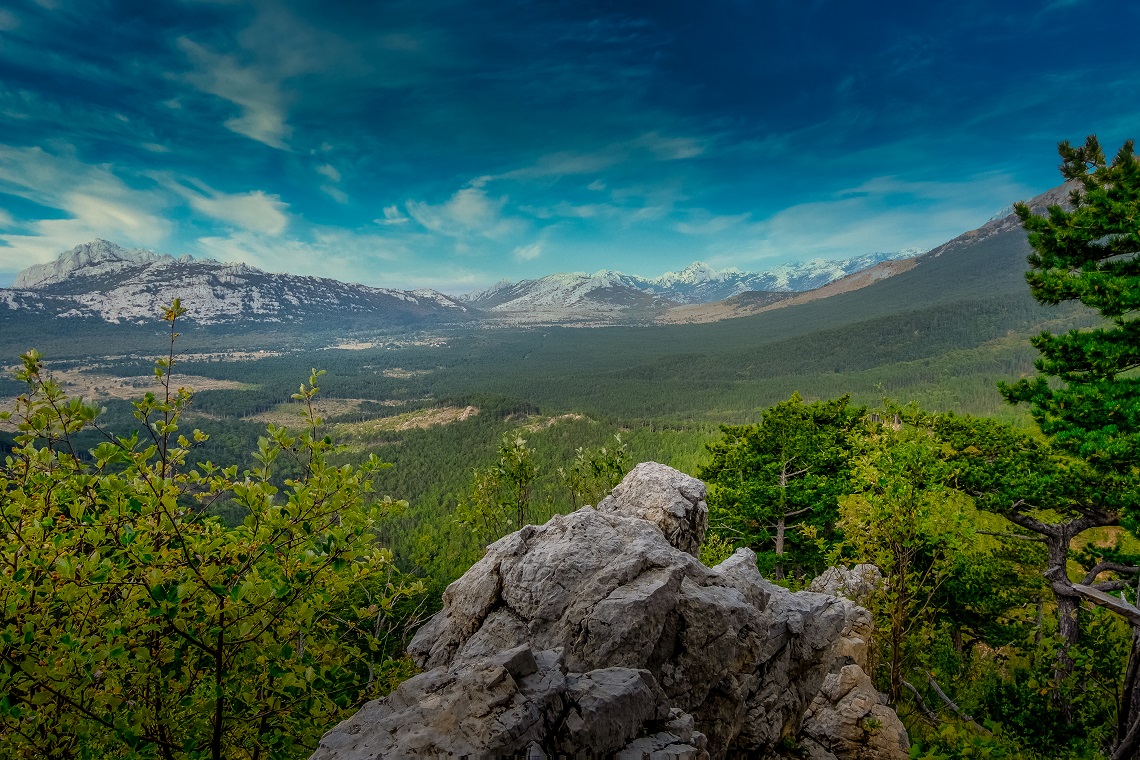
As with most treks, the realisation that the end is near was both encouraging and a little dispiriting — “all good things must come to an end” and all that. But I had picked up phone reception for the first time since I’d begun the trek and learnt that I was now required to self-isolate for 14 days back in England. It was a pointed reminder that we were living in extraordinary times and, despite the glimmers of light at the end of the tunnel, there was still a long way to go.
The final day included one last ascent before descending into Velika Paklenica gorge of Paklenica National Park. The gorge is a steep-sided canyon known for its rock climbing and cave systems. Its cool walls brought a welcome relief from the midday sun. After exiting the gorge there were just a couple more miles of tarmac before I arrived at the finish line, located right on the beach at the resort town of Starigrad-Paklenica.
After receiving medals, certificates, and final stamps, hikers dived into the cool Adriatic for a refreshing dip before making a beeline for the bars that line the beach for fresh beer and pizza.
ON REFLECTION
Generally, I tend to trek on my own. Most of my friends in the UK aren’t really interested in trekking and prefer to spend their precious holiday time relaxing instead of lugging a backpack over mountain passes. Likewise, even though my partner enjoys a day hike, she draws the line at multi-day treks. The Highlander trek was a great way to meet like-minded people and socialise while on the trail. Even though I joined as a solo hiker — and while it was easy to find solitude on the trail — other walkers were never far away and always happy to pause for a chinwag.
The evenings were sociable affairs with participants sharing stories around a campfire. I’ve stayed in touch with several of those I met on the trail and we’re already planning other events to join this year. At the same time, even though trekkers all begin at the same point, they soon spread out, as participants walked at different paces, chose different routes, and camped at different spots, so the trail never felt crowded or overrun.
Perhaps the best aspect of the trip was that it revealed an intriguing expanse of wilderness to me that can be easily reached from the UK. Three-quarters of a billion people call Europe — the world’s second-smallest continent — home. Finding peace and quiet among its 50-odd nations with their transient people and smorgasbord of cultures is not straightforward. But nestled in a small chain of mountains between continental Croatia and the Adriatic coast is a footpath that offers just that.
The last year or so has seen our collective sense of adventure dampened and stifled. But as the world starts to reopen, we need to think boldly again, rekindle our desire to roam far and wild. The Velebit Mountains of Croatia may just have the answer. They’ve been hiding one of Europe’s great treks and it’s perfect for a post-lockdown adventure.
WHO’S WRITING?
 Peter Watson is a photographer, writer and founder of outdoor travel blog Atlas & Boots. A keen trekker and climber he can usually be found on the trails of the Greater Ranges. He’s visited over 80 countries and is currently focused on climbing the seven summits — the highest mountain on every continent. So far, he’s scaled Kilimanjaro in Africa, Elbrus in Europe, Kosciuszko in Oceania and most recently Aconcagua in South America. He still has Denali in North America, Vinson in Antarctica and Everest in Asia to climb (although he also plans to summit Puncak Jaya in Indonesia to complete the two separate versions of the seven summits lists). When not overseas he lives with his partner in the Yorkshire Dales.
Peter Watson is a photographer, writer and founder of outdoor travel blog Atlas & Boots. A keen trekker and climber he can usually be found on the trails of the Greater Ranges. He’s visited over 80 countries and is currently focused on climbing the seven summits — the highest mountain on every continent. So far, he’s scaled Kilimanjaro in Africa, Elbrus in Europe, Kosciuszko in Oceania and most recently Aconcagua in South America. He still has Denali in North America, Vinson in Antarctica and Everest in Asia to climb (although he also plans to summit Puncak Jaya in Indonesia to complete the two separate versions of the seven summits lists). When not overseas he lives with his partner in the Yorkshire Dales.



